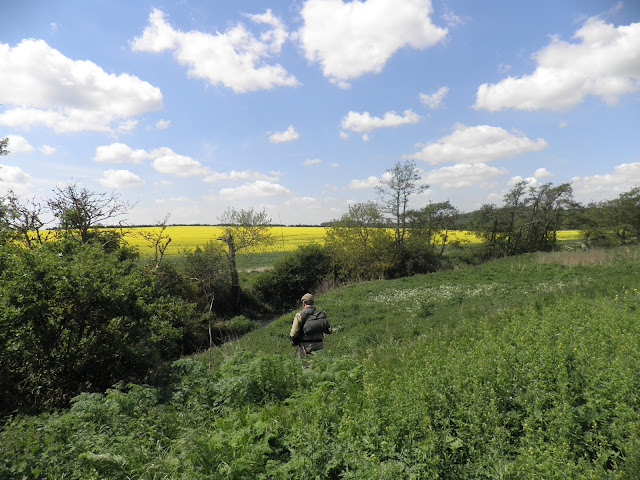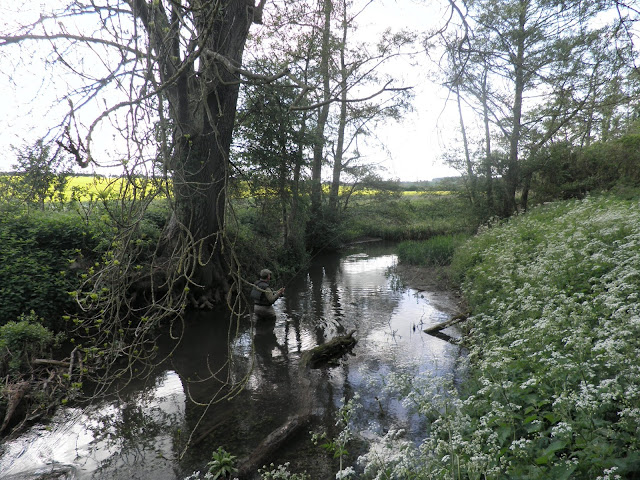River Gwash, Rutland
The East Midlands of England could not by any stretch of the imagination be considered a region with an
abundance of trout streams. There is of course the wonderful trout fishing
in the Derbyshire Peaks on the very western edge of the region, but I have
in mind the flat, low lying expanse of land to the east of the peaks where
rivers of the kind preferred by trout are rare. Here, most of the fly fishing opportunities
are focused on a cluster of large man-made reservoirs such as Rutland Water, Pitsford, Ravensthorpe, Eye Brook and, crossing the divide into East Anglia, Grafham. By all accounts, they offer
excellent fishing if stillwater fishing is your cup of tea. The handful of streams which do harbour trout are locked away in the hands of private
owners or fishing clubs with long waiting lists. It isn't the easiest place to
gain access to river trout fishing.
One such river is the Gwash in
Rutland, which was dammed to create Rutland Water reservoir in the 1970s, the
largest reservoir in England by surface area. Rutland is a very popular
fly fishing venue with rainbow and brown trout stocked in their thousands each
year.
For about six miles downstream of the reservoir, before the Gwash spills into the larger River Welland just east of Stamford, the river is what would be described by American readers as a 'tailwater' fishery (the flow is regulated and water temperature is affected by the release of colder water stored at the bottom of the reservoir near the outlet). Much
of the fishing here is in the hands of a fishing club but a couple of miles are held
privately by Andrew Flitcroft, editor of Trout & Salmon magazine. I snapped
up a rare opportunity to fish this private section with Andrew through a winning bid in the Wild
Trout Trust’s annual auction.
In case you are wondering, the outflow from the reservoir is through an underground pipe so there is no chance of any large, grown-on fish escaping into the Gwash downstream!
Interestingly, I recalled reading the name Gwash
in an online snippet at the time I fished the River Wye in Derbyshire last
year. The Gwash was named as one of eleven rivers in Britain with a spawning
population of rainbow trout in E. Barton Worthington’s 1941 survey of rainbow
trout in Britain (commissioned due to concerns that rainbow trout were ousting
brown trout in British rivers). Today, it would seem that any population of self-sustaining
rainbow trout in the Gwash has long since disappeared.
Perhaps swallowed up by the construction of the reservoir?
Andrew is down-to-earth and clearly
very passionate about fly fishing, and I enjoyed his company. He was an
obliging host and a skilful fly fisherman to boot. Whilst enjoying a pretty
authentic American diner breakfast, Andrew mentioned that his section of the
river is divided into an easier beat downstream, with generally smaller fish,
and a more difficult beat upstream, with...you guessed it... generally larger
fish. We headed for the upstream section first. Parking near to the river, it
became clear that the temperature forecast of less than 10 degrees was
hopelessly wrong. With relatively clear skies it promised to be a beautiful,
warm day with good prospects for a decent hatch.
The river was hidden by a
sinuous slip of green vegetation at the basin of the shallow valley. The fields
on the near bank were bare and exposed, recently ploughed between the hedgerows, whilst the fields
on the far bank were awash in the yellow of blooming rapeseed. I was
immediately struck by the blissful absence of any man made sound, interrupted only by the intermittent sounds of light aircraft and a bird scare device in
a nearby field.
The Gwash is a small river with a
gentle flow. Andrew commented that the river was showing a little more colour
than usual, but it was still clear enough to spot fish easily enough. We
carefully walked upriver, looking for signs of fish and places where a cast
could be made to them. Eventually we came across a feeding fish holding position
in a place where I could enter the water downstream and cast to it. I quietly
slipped down the nettle covered bank and into the silty bank ooze. Wading in
the stream caused blooms of watery dust to billow downstream. The level of silt
is a by product of the reservoir upstream - the volume of the outflow is
regulated and the lack of flooding means that the river is not flushed clean as
nature intended. This upstream section has not yet been worked on by Andrew and
his syndicate members, but later I would see the good work done to combat the
silt in the downstream beat.
At that moment in time however my concentration
was squarely focused on the trout rising in front of me. My first and second
cast saw my 7x tippet coiling like a tightly wound spring around my leader without
spooking the fish, so I changed it to 6x and waited a while for the fish to
rise again. When it did I cast again, this time the leader unfurled properly
and delicately landed on the water, and the trout obliged by sipping in the small
olive CDC pattern. It proved to be a good fish of about 12 inches, beautifully
marked and wild.
As the day started to heat up mayflies emerged and with their appearance the fish noticeably became a little less
cautious. As did I when I waded a little too carelessly in the silt next to the
river. I became stuck and a little apprehensive when I realised that I was
slowly sinking. I threw my rod, backpack and chestpack on to the bank and tried
to dig myself out to no avail. Andrew, who had wandered off to spot fish, came
to my assistance when he realised I had been gone awhile but couldn’t pull me
out either. I had visions of Andrew having to call a local farmer to bring a
tractor to drag me out and the ensuing embarrassment. Eventually I was able to
free my right leg from the mire and use it to dig a funnel for river water to
flood in and dilute the ooze ensnaring my trapped left leg. My left leg finally
loosened and became free and Andrew pulled me out whilst I grabbed a handful of
nettles – anything – with my free hand to pull myself up the bank. Muddied, out
of breath but free, we both laughed with some relief at my recent predicament.
Very soon it was all business
again as we spied a good fish feeding next to our bank just a little way
upstream. We watched it feed for a little while and I enjoyed adopting the
patient and visual approach to fishing that Andrew employed. I changed patterns
to a mayfly, slipped into the water – after Andrew assured me that the bottom
was hard – and crept into position. I overcooked the first two casts and was
too wide to the left with the third. Andrew suggested that I hold off for a few
minutes to see if the fish was spooked or still feeding. Within a few minutes,
the fish rose again and I breathed a sigh of relief. My fourth cast was perfect
and my fly was confidently swallowed by the trout. I lifted my rod and could immediately
tell by the bend that it was a good fish. Andrew helped me to net it, a good
fish of about 14 inches, with bold vermilion spots on its flanks.
Another trout
had been rising a little way upstream and a further cast saw this fish come to
the net too. Again, this fish was a good size for the limited proportions of the stream, about
12 or 13 inches. Andrew later enticed a similar sized fish from the upper limit
of the beat to conclude a successful “morning session” (it was closer to 3.30pm
when we checked the time).
We drove down to the lower beat
and the work that had been put in to the river to
make the trout habitat better, and improve the fishing, was immediately apparent, including tree clearance,
narrowing the river channel, creating bends and the insertion of groynes. The fish
did prove to be a little smaller, but no less fun to catch and I managed to
tempt another seven trout to take a dry fly. In the low evening sun it was sometimes
possible to see into the water and observe the fishes’ reaction to the dry fly,
which must be one of the most exciting moments of dry fly fishing.
It was a real privilege to have
fished this private river and I will savour the experience for some time to
come.











This little river (The Gwash) has a place in my heart as it's close to home, and feeds my favourite reservoir too. A nice write up and some great pictures. Thanks.
ReplyDeleteHello Richard - it's a lovely little river. I'm glad you enjoyed this post.
ReplyDeleteI am encouraged in a way that what might be considered the "hallowed waters of England", also have ooze and mud and nettles. Here in South Africa MOST fishermen avoid rivers that present with these difficulties, preferring those that offer easy access and a little less effort. Do you find this in your part of the world? Are we part of a very small and shrinking group who are prepared to tolerate these minor discomforts?
ReplyDeleteHi Andrew. I enjoyed reading your blog. It brought back memories of home.
ReplyDeleteReward lies for those willing to venture the extra mile. This does not necessarily mean being rewarded by bigger fish because often it does not, but it can be the satisfaction that comes with fishing an unfished stream or tempting a trout from a difficult lie. But I agree with you, in my experience many people are content to take it easy and put in the minimum amount of effort required.
Well I guess the general trend of minimum effort is what gives a few of us uncrowded river beats!
DeleteKeep up the great blog.
The Gwash at Empingham was the river I fished as a boy. It is my favourite river. The milkman, Roger Corby, was kind enough to give permission and I also had permission from Mr Partridge who lived at Prebendal House. I must of spent well over a thousand days fishing there. I'll never know another river as well as I knew the Gwash. I frequently dream about being there even though I've not fished it for over 30 years. Looking back I feel fortunate to have had such a beautiful place to fish minutes from where I lived. I've loved reading this diary entry and looking at the photos - thanks very much!
ReplyDeleteI'm pleased that my entry and photos evoked such wonderful and obviously heartfelt memories about the Gwash. Thank you, I enjoyed reading about them.
Delete